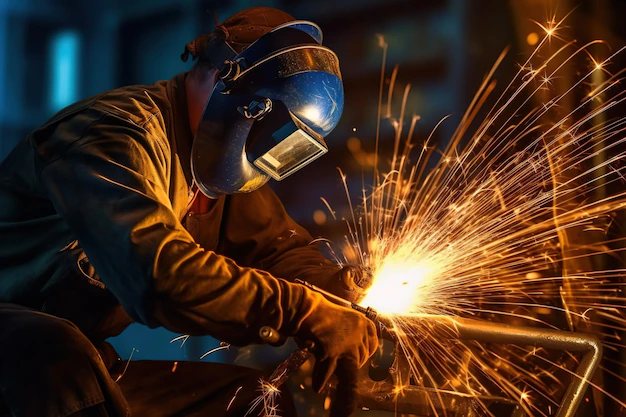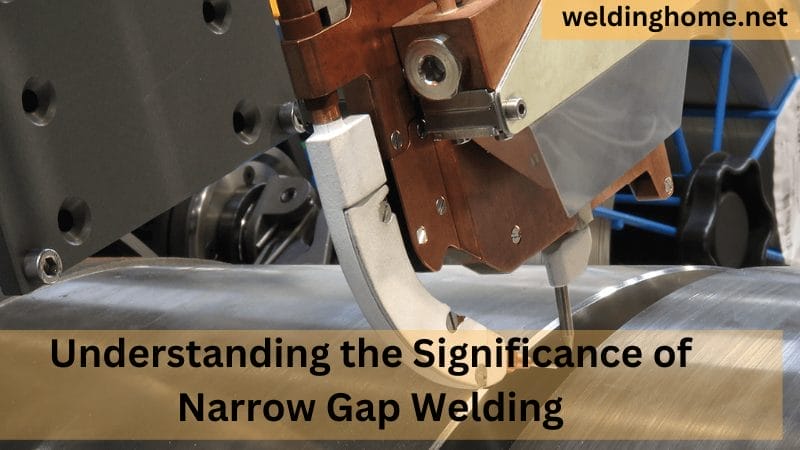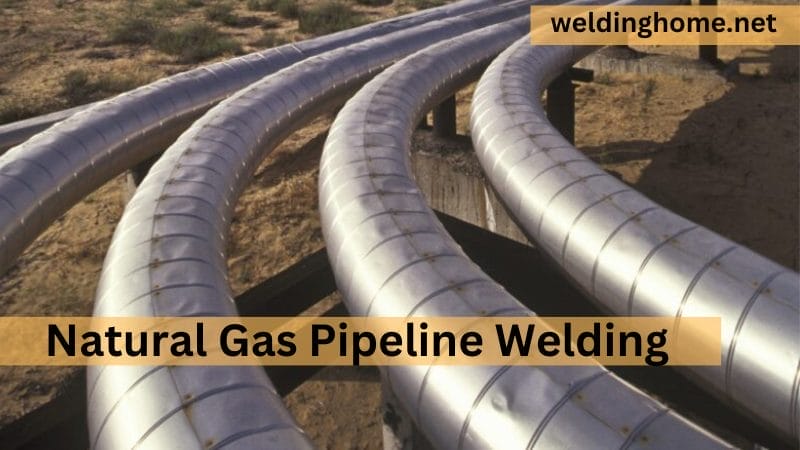What is Gas Metal Arc Welding?

Introduction
What is Gas Metal Arc Welding? MIG welding, or Metal Inert Gas welding, is a popular technology in various industries and applications. It is a versatile and effective process for connecting different types of metals.
However, when it comes to the final weld joint quality, you can get identical results by following the necessary methods and making proper preparations. Mastering the correct procedures and following the essential safeguards will allow you to construct high-quality welds easily.
In this post, I will look at Gas Metal Arc Welding principles, its benefits and modern application.
Let’s glimpse this enthralling world of MIG welding and see how you may produce excellent results without the intricacy and fussiness generally associated with TIG welding aluminium.
The Process of Gas Metal Arc Welding
During Gas Metal Arc Welding, the welding torch, fueled by a specialized electrical current, securely holds the consumable wire electrode. As the welding torch moves forward, the electrode is continuously fed until it reaches the point of contact with the workpiece.
At the same time, a shielding gas is skilfully released around the arc, diligently protecting the molten metal from any negative ambient impacts. The ensuing electric arc generates a lot of heat, melting the consumable electrode and blending it perfectly with the weld pool.
The necessary weld quality is expertly attained by carefully manipulating welding variables such as voltage, current, and wire feed speed.
Advantages of Gas Metal Arc Welding

Gas Metal Arc Welding (GMAW) has multiple advantages, including versatility in welding different metals, high efficiency for rapid weld metal deposition, great weld quality, and minimum post-weld cleaning requirements.
Flexibility:
The ability of GMAW to handle varied materials with precision and efficiency strengthens its position as an industry-leading welding technology.
High Efficiency:
GMAW is a high-speed welding method that enables quick weld metal deposition. Because of the constant wire feeding and automated torch movement, it is an efficient alternative for large-scale applications.
High Weld Quality:
Gas Metal Arc Welding produces welds with high mechanical qualities. The regulated shielding gas keeps the weld pool clean by insulating it from ambient contaminants. As a result, the weld joints are clean and sound.
Minimal Post-Weld Cleaning:
GMAW creates less spatter than conventional welding methods, minimizing the need for substantial post-weld cleaning. This saves time and effort, which is especially important in applications requiring a clean appearance.
Versatility:
Gas Metal Arc Welding (GMAW) exhibits remarkable versatility, enabling it to seamlessly join a diverse spectrum of metals, including carbon steel, stainless steel, aluminum, and copper alloys. This exceptional adaptability empowers GMAW to cater to the needs of various industries, such as automotive manufacturing, construction, and fabrication, making it an invaluable asset in the welding world.
High-quality welds
Good mechanical properties are produced by gas metal arc welding. Clean and sturdy weld joints are made due to the controlled shielding gas protecting the weld pool from atmospheric contamination.
Minimal Post-Weld Cleaning:
GMAW produces the least spatter compared to other welding processes, negating the demand for thorough post-weld cleaning. This reduces time and work, particularly in applications where a neat appearance is important.
Gas Metal Arc Welding Applications
Several different industries and sectors use gas metal arc welding. Examples of typical applications include:
Gas Metal Arc Welding (GMAW) is widespread across numerous industries. It is widely used in the production of automobiles for the fabrication of exhaust systems, body panels, and vehicle frames.
GMAW is used in the construction industry to join structural steel members. It is additionally used in the oil and gas sector to weld components and pipelines. GMAW is widely used in fabrication and manufacturing procedures for various metal-based products.
1. Automotive Manufacturing:
Fabricating vehicle frames, body panels, exhaust systems, and other components uses GMAW extensively in the automotive sector. It helps the mass production of automobiles because of its speed and effectiveness.
2. Structural Steel Fabrication:
In infrastructure and construction projects, structural steel members are joined using GMAW. It produces strong, long-lasting welds that guarantee structural integrity and stability.
3. Pipelines and Oil Refineries:
Gas metal arc welding joins pipelines and other oil and gas industry parts. The harshest environmental conditions are withstood, and it guarantees leak-free joints.
4. Manufacturing and Fabrication:
Metal furniture, appliances, machinery, and other products made of metal are produced using GMAW, which is widely used in manufacturing and fabrication processes.
Gas Metal Arc Welding Safety Considerations
Prioritizing safety is crucial when performing Gas Metal Arc Welding to avoid mishaps and guarantee a safe working environment. Here are some things to keep in mind regarding protection:
To protect yourself from arc radiation and sparks, wear the proper personal protective equipment (PPE), such as a welding helmet, gloves, and flame-resistant clothing.
Ensure the welding area has adequate ventilation to prevent the buildup of dangerous gases and fumes.
Observe electrical safety regulations and routinely check welding equipment for any potential hazards.
Implement fire safety precautions, such as keeping flammable materials out of the work area and keeping a fire extinguisher nearby.
Advice for Gas Metal Arc Welding Success
Take into account the following advice to get the best results from gas metal arc welding:
To prevent rust, oil, or dirt from affecting the weld quality, thoroughly clean the workpiece.
Place the welding torch at the proper angle and maintain a constant travel speed to ensure even heat distribution.
Optimize the welding parameters depending on the joint design, material thickness, and desired weld characteristics.
Wire feeding techniques prevent wire jams and guarantee a stable and smooth arc.
To keep the welding equipment in top working condition, perform routine inspections and upkeep.
Regular Problems with Gas Metal Arc Welding
There could be issues with Gas Metal Arc Welding that need attention and troubleshooting. Common problems include:
Gas bubbles trapped in the weld pool can lead to porosity, weakening the welds. Porosity can be reduced with the right gas selection for shielding and gas flow rate adjustment.
Spatter: During welding, molten metal may be accidentally expelled. Spatter can be reduced by modifying the welding parameters and using anti-spatter products or coatings.
Lack of fusion: A weak joint can result from insufficient fusion between the base and weld metal. This problem can be solved using the appropriate welding techniques, joint preparation, and heat input.
Upcoming Changes to Gas Metal Arc Welding
Gas Metal Arc Welding is anticipated to experience more advancements as technology develops. Some potential GMAW trends for the future include:
Automation and robotics: Incorporating robotic systems in GMAW can improve welding operations’ accuracy, productivity, and consistency.
Advanced Control Systems: The creation of intelligent control systems can real-time adjust welding parameters, improving the efficiency and quality of the weld.
Improved Material Compatibility: Work is being done to increase the number of materials that can be used with GMAW, including high-strength and unusual metal alloys.
Conclusion
MIG welding, or gas metal arc welding, is a flexible and effective welding technique in various industries. It is a preferred option for many applications due to its capacity to weld multiple metals together, high efficiency, and good weld quality.
One can achieve successful GMAW results by adhering to the necessary safety precautions, optimizing welding parameters, and addressing common challenges. Gas metal arc welding is expected to advance.
FAQ’S
What do you mean by gas metal arc welding?
Gas metal arc welding (GMAW) is an arc welding process in which the heat source is formed between a consumable metal electrode and the workpiece with an externally supplied gaseous shield of gas either inert such as argon and helium [5].
What are the parts of GMAW?
The typical GMAW welding gun has several key parts—a control switch, a contact tip, a power cable, a gas nozzle, an electrode conduit and liner, and a gas hose.
Which gas is generated during GMAW?
Gas Metal Arc Welding: Modeling
The main gases used in the GMAW process are inert (argon and helium) and small quantities of oxygen or carbon dioxide.
.






